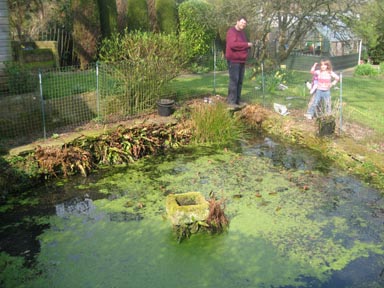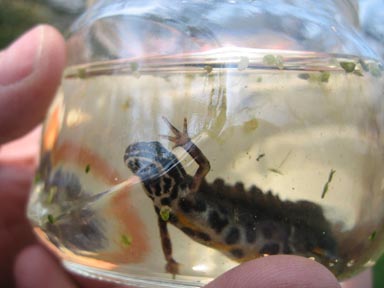No newts is NOT good news
By Ruth D’Alessandro, The Wildlife Gardener Thanks to all who had a go at last month’s Puzzle Corner ” the answers are on the comments after the original post. Spring has finally come to the Wildlife Garden, and there are things to report.

We live in an area of chalk downland and clay. Where a permeable chalk layer meets an impermeable clay layer, a ‘spring line’ is formed. There are lots of little natural springs in the woods behind the house, and The Wildlife Pond is fed by one too. Enough water seeps in to equal the amount of water that evaporates, and the level, strangely, remains the same whether there is drought or torrential rain. The sludge at the bottom of a pond behaves like a compost heap: bacteria and other micro-organisms break down the organic material to nourish the ecosystem, and for this, they need sunlight. The pond was completely covered with a thick light-blocking layer of duckweed that needed to be skimmed off to allow the light through. Pond skaters were not skating but fell-walking. Spring is not the ideal time to disturb a pond, and I thought my skimming would be a quick and uneventful half-hour, a bit of a chore. How wrong I was. The first netful turned up a 5cm dragonfly nymph. I gathered the family around for a ‘show and tell’. Everyone went back indoors. The second netful pulled out a great diving beetle and some freshwater shrimps. The family was summoned again. To everyone’s excitement the pile of duckweed on the side of the pond started to thrash about, revealing a smooth newt in mating livery.

My companionable robin, a parent himself, picked through the duckweed pile and carried off to his young nestlings a ‘plateau de fruits de pond’ of crustaceans and nymphs that I had missed throwing back. More pond beetles, freshwater snails, a rat-tailed larva, two more newts (one of which may be a palmate) and thousands of tadpoles warming up on sunken leaves came to light from under the duckweed. I resisted pulling out leaves as newts wrap their eggs in them. Two thirds of the pond are now clear of duckweed and the fauna is able to move about more easily. Pond skaters skate again. There are easily 20 resident newts. Fish will never be part of the wildlife pond because they eat the eggs and larvae of everything. I can’t understand the appeal of a goldfish pond because fish are boring and do very little, whereas tadpoles, snails, amphibians, beetles and nymphs create different mini-dramas every time I sit quietly and observe. The Wildlife Garden Notebook for March and April Bird species seen this month Blackbird, songthrush, robin, collared dove (still no sign of the mate), wood pigeon, tits: blue, great, and long-tailed, chaffinch, greenfinch, hedge-sparrow, jackdaw, magpie, wren, nuthatch, woodpeckers: green and greater spotted, TREE sparrows Mammal species seen this month Grey squirrel, dead badgers on A25, bats in the garden Insect/arachnid species seen this month Bumble bees, hoverflies, a queen wasp, a crab spider Pond species seen this month Newts ” smooth and possibly palmate, frog tadpoles, pond snails, great diving beetles, smaller pond beetles, dragonfly nymphs, pond skaters, freshwater shrimps Garden Plant species in evidence Lungwort, daffodils, periwinkle, hyacinths, grape hyacinth, everything starting to bud Vegetables Greenhouse and indoors: Tomatoes, squash and cucumbers all thriving, peas, onions, brassicas starting to shoot, beetroot, and parsnips grown in plugs as an experiment, broad beans, coriander and basil. One row of first early potatoes. No of bin bags this month 3.5! Try to find a wildlife pond this month and take at least 10 minutes to sit and watch it. I guarantee you will not be disappointed! Happy Dipping! The Wildlife Gardener
- Spurn Spawn! - 26th February, 2014
- Bluebells on wheels: axles of evil? - 2nd February, 2011
- Raising the ba: Wildlife and the Ancient Egyptian Book of the Dead - 8th January, 2011

376
Hi Jane! For sheer fascination, a pond is hard to beat! The dragonfly cases are called exuviae and they are the skins shed by dragonfly and demselfly larvae as they grow. They may shed their skins up to 12 times in the course of their nymph stage. Newts – we love ’em too, and great diving beetles that are hard to miss. Watch out for my next post, as a protected predator appears on the scene… Enjoy your pond!
Hi there,
Well this afternoon again as I laid by the pond there came again 2 blue and one red dragonflies.
Im so fascinated by this wildlife pond in our garden, there are loads of newts and I have found 2 (which look empty) dragonfly nymph things.
Ive never seen anything like it before, I was rather over whelmed to say the least.
Unlikely – but just possible. See this project on migrating dragonflies from the British Dragonfly Society.
Hear Hear! Perhaps your dragonfly started off life in my pond!
What a treat to have such a thriving eco-system in your garden. My little balcony, with its tubs of drought-tolerant plants and bird feeder, is always a-buzz with bees, flies, other invertebrates and the occasional dragonfly, plus many types of bird. Last year, some intrepid pigeons laid an egg there!
It just goes to show that anyone can help and enjoy the wildlife in their tiny patch of England (or wherever).